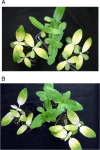Genomic and mutational analysis of Pseudomonas syringae pv. tagetis EB037 pathogenicity on sunflower
- PMID: 39856564
- PMCID: PMC11760712
- DOI: 10.1186/s12866-024-03685-8
Genomic and mutational analysis of Pseudomonas syringae pv. tagetis EB037 pathogenicity on sunflower
Abstract
Background: Pseudomonas syringae pv. tagetis (Pstag) causes apical chlorosis on sunflower and various other plants of the Asteraceae family. Whole genome sequencing of Pstag strain EB037 and transposon-mutant derivatives, no longer capable of causing apical chlorosis, was conducted to improve understanding of the molecular basis of disease caused by this pathogen.
Results: A tripartite pathogenicity island (TPI) for a Type III secretion system (T3SS) with the complete hrp-hrc gene cluster and conserved effector locus was detected in the Pstag genome. The exchange effector region of the TPI contained genes potentially functioning in detoxification of the environment as well as two integrases, but no previously described T3SS effector homologues. In all, the Pstag EB037 genome contained homologues for at least 44 T3SS effectors with 30 having known functions. Plasmids similar with pTagA and pTagB of P. syringae pv. tagetis ICMP 4091 were also identified in the Pstag genome. The pTagA-like plasmid contained a complete Type IV secretion system (T4SS) with associated putative killer protein. Mutational analysis using transposon insertions within genes functioning in the T3SS and T4SS confirmed the role of both secretion systems and these plasmids in apical chlorosis. Transposon mutagenesis identified an additional 22 genes in loci, including two more plasmid-bound loci, involved in apical chlorosis on sunflower; some with known importance in other plant or animal pathosystems.
Conclusions: Apical chlorosis disease caused by Pstag EB037 is the result of a complex set of mechanisms. This study identified a TPI and homologues for at least 44 T3SS effectors, 30 of which with known functions in disease, and another 20 genes in loci correlated with apical chlorosis on sunflower. Two plasmids were detected that were correlated with apical chlorosis disease, one of which contained a complete T4SS that was correlated with disease. To our knowledge, we provide the first direct evidence for a T4SS functioning in disease by a pathogenic P. syringae strain.
Keywords: Pseudomonas syringae pv. tagetis; Apical chlorosis; Disease; Effectors; Sunflower; Type III secretion system; Type IV secretion system.
© 2025. This is a U.S. Government work and not under copyright protection in the US; foreign copyright protection may apply.
Conflict of interest statement
Declarations. Ethics approval and consent to participate: This study complies with relevant institutional, national, and international guidelines and legislations. All procedures were conducted in accordance with the guidelines. Consent for publication: Not applicable. Competing interests: The authors declare no competing interests.
Figures



Similar articles
-
Construction of a bacterial artificial chromosome library and characterization of hrp/hrc gene cluster of Pseudomonas syringae pathovar tagetis LMG5090.Biotechnol Lett. 2006 Jul;28(13):969-77. doi: 10.1007/s10529-006-9027-5. Epub 2006 Jun 24. Biotechnol Lett. 2006. PMID: 16799767
-
Naturally occurring nonpathogenic isolates of the plant pathogen Pseudomonas syringae lack a type III secretion system and effector gene orthologues.J Bacteriol. 2008 Apr;190(8):2858-70. doi: 10.1128/JB.01757-07. Epub 2008 Feb 8. J Bacteriol. 2008. PMID: 18263729 Free PMC article.
-
Comparative genomic analysis of the pPT23A plasmid family of Pseudomonas syringae.J Bacteriol. 2005 Mar;187(6):2113-26. doi: 10.1128/JB.187.6.2113-2126.2005. J Bacteriol. 2005. PMID: 15743960 Free PMC article.
-
Closing the circle on the discovery of genes encoding Hrp regulon members and type III secretion system effectors in the genomes of three model Pseudomonas syringae strains.Mol Plant Microbe Interact. 2006 Nov;19(11):1151-8. doi: 10.1094/MPMI-19-1151. Mol Plant Microbe Interact. 2006. PMID: 17073298 Review.
-
Pseudomonas syringae type III secretion system effectors: repertoires in search of functions.Curr Opin Microbiol. 2009 Feb;12(1):53-60. doi: 10.1016/j.mib.2008.12.003. Epub 2009 Jan 23. Curr Opin Microbiol. 2009. PMID: 19168384 Review.
References
-
- Alfano JR, Charkowski AO, Deng W-L, Badel JL, Petnicki-Ocwieja T, van Dijk K, Collmer A. The Pseudomonas syringae Hrp pathogenicity island has a tripartite mosaic structure composed of a cluster of type III secretion genes bounded by exchangeable effector and conserved effector loci that contribute to parasitic fitness and pathogenicity in plants. Proc Nat’l Acad Sci USA. 2000;97:4856–61. - PMC - PubMed
-
- Aliev AE, Karu K, Mitchell RE, Porter MJ. The structure of tagetitoxin. Org Molec Chem. 2016;14:238–45. - PubMed
-
- Allocati N, Federici L, Masulli M, Di Ilio C. Glutathione transferases in bacteria. FEBS J. 2009;276:58–75. - PubMed
-
- Altschul SF, Gish W, Miller W, Myers EW, Lipman DJ. Basic local alignment search tool. J Molec Biol. 1990;215:403–10. - PubMed
MeSH terms
Substances
Grants and funding
LinkOut - more resources
Full Text Sources
Miscellaneous

